
For (literally) hundreds of years, gay bars have provided this critical sustenance in the lives of both LGBTQ+ individuals and the LGBTQ+ community writ large.
Now a new effort is underway to memorialize one of Ohio’s most legendary gay bars with what would be only the state’s third-ever LGBTQ+-related historical marker.
In 2009, a marker was installed in Dayton honoring Natalie Clifford Barney, an out lesbian writer who convened literary salons in Paris that influenced generations of writers. Then in 2017, a marker was installed in Cleveland commemorating the block of West 29th Street that was home to Cleveland’s vibrant LGBTQ+ community.
Now here in 2022, a third LGBTQ+ marker has been approved — the first for Columbus — honoring a storied lesbian establishment.
Opened in 1980, Summit Station was Ohio’s first and longest-running lesbian bar. Located on Summit Street in almost the exact geographical center of Columbus, owner Petie Brown says the space was one of the first three lesbian bars in the United States.
Summit Station quickly became more than a bar.
“Summit Station was here at a time where people didn’t have other places to go,” explains Julia Applegate, one of the individuals leading the effort to install the historical marker. “It wasn’t just a place to drink and hang out. It was a place for everything.”
To learn more about the relevance of the historical marker at Summit Station, The Buckeye Flame spoke with Applegate and Ben Anthony, the manager of community engagement at the Ohio History Connection.
How would you describe the significance of Summit Station?
Julia Applegate [JA]: The bar was really more like a community center and gathering space. It was a safe space at a time where there was still a lot of violence, including police and community-based violence towards LGBTQ+ people.
All kinds of activities took place at the bar: baby showers, weddings, break-ups, make-ups, fundraisers, support groups, performances, dart leagues, billiards, karaoke, and meetings after games. It was really like a little bit of everything happened there. Summit Station was here at a time where people didn’t have other places to go. It wasn’t just a place to drink and hangout. It was a place for everything.
Ben Anthony [BA]: Right now in Ohio we have two LGBTQ+ historical markers. The marker program highlights local history as brought forth by the community. We had about 68 applications this year and we are usually only able to select somewhere around 20 markers. It was really exciting that we will be able to have this third LGBTQ+ historical marker in the state and our first in central Ohio.
What was one of your favorite memories working on this project?
JA: I was a patron of the bar for years and so for me it was meeting [owner]Petie [Brown] and just learning about her commitment to providing a welcoming space that was inclusive to everybody. I think that not every bar owner does that but Petie was very family oriented in how she ran her establishment.
BA: So much of the credit belongs to an intern we had at the History Connection named Quincy Balius, who poured herself into this research. The coolest thing for me was to watch someone young in the LGBTQ+ community dig through this history, do the research and help build the application for their elders. This intergenerational story honoring the past by the future is the thing that is so exciting to me.
Quincy isn’t even from Ohio. She was living in Montana the entire time that she was working on this project. She cared very deeply and found us. We were so fortunate to have made that connection because she, Julia, and the former patrons were the driving factor behind the application being robust enough to be selected.
What does having a historical marker mean to you?
JA: For me personally it’s a form of validation. Historical markers validate the fact that a place and people of a particular time existed. It’s a public acknowledgement of the importance of our segment of the community and for me that’s extremely important because LGBTQ+ communities have not been publicly recognized but rather hidden and marginalized. A historical marker is really a public validation that we lived, loved, fought, and that our lives are significant in the same ways that straight people’s lives are significant.
BA: What this means to me personally as the manager of the community engagement department at the History Connection is that we are doing our jobs of telling a more complete history of Ohio. This is how we do our job as best as humanly possible in telling a more complete history of Ohio. That’s our mission to serve every Ohioan and their history, narrative, and identity and this helps us do that one marker and step at a time.
How important is it in 2022 to have a space like Summit Station?
JA: I think this answer depends on who you ask. The advances the LGBTQ+ community has made has almost put bars like this out of business because people don’t feel the need to go to queer spaces because mainstream spaces are safer than they used to be. At the same time, I think that if you really are longing to be in community with people who are like you, there is a value in having spaces that are catered to sub-populations.
For me I miss the days of a bar like Summit Station because it was casual. Petie hosted gatherings on Thanksgiving and Christmas for people who couldn’t go home to their families. It wasn’t just 10 or 12 people. It was a lot of people since a lot of people were rejected by their families. That still happens, so I personally believe there is still a space for LGBTQ+ bars, restaurants and nightclubs.
For younger individuals who have grown up in a more inclusive time, I still hear a number of them longing for the days when these spaces existed. When every space is open to everybody you can get all mixed up. In a way that is nice because you don’t have to hide, but it’s also hard to find your people.
BA: I think our communities these days are really redefining what community means and as well as the ties that bind us. If you look at the LGBTQ+ bar scene now, it is drastically different than it was at the time of Summit Station. But the need for community and interconnectedness hasn’t changed. There is still the need for support, friendly faces, love, and care from the people who are in our communities, but the method and modalities are being shaken up and reinvented constantly now.
This marker celebrates a snapshot of time where communities convened in a space that was safe for them, where they could be themselves and find the love and support inside their own community.
There is a fundraising campaign to raise $5,000 to install this historical marker.
This story was originally published in The Buckeye Flame and republished here with permission.
Coming soon: CityBeat Daily newsletter. We’ll send you a handful of interesting Cincinnati stories every morning. Subscribe now to not miss a thing.
Follow us: Google News | NewsBreak | Reddit | Instagram | Facebook | Twitter





